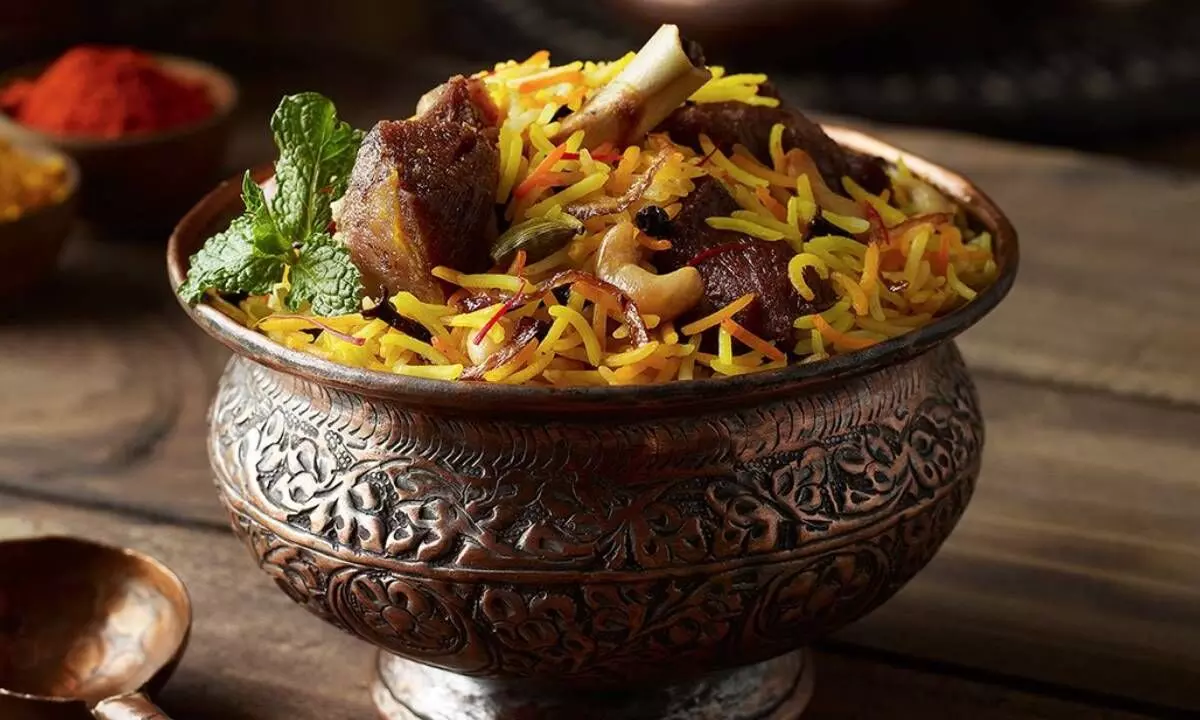Hyderabadi Biryani: A Tale of Tradition, Flavors, and Culinary Diversity
image for illustrative purpose

Hyderabadi Biryani is renowned for its unique characteristics that distinguish it from other regional variations. The Persian origin of the word "Biryani" sheds light on the cooking process, with Hyderabadi Biryani featuring partially roasted meat at the bottom of the vessel due to high heat. In contrast, biryanis from Lucknow, Kolkata, Dindigul, Ambur, and Thalassery are cooked with ample water, eliminating any roasting of the meat.
To achieve the perfect Hyderabadi Biryani, a specially designed vessel called a "degh" is used. Its wider bottom and tapering top allow for sealing after layering the rice, and flaming charcoal is placed on top to ensure even cooking.
Two distinct cooking methods contribute to the rich flavors of Hyderabadi Biryani. In "Kache Gosht ki Biryani," raw marinated meat and rice are cooked together, while "Pakki Biryani" involves separately cooking the ingredients and then mixing them.
The essence of Hyderabadi Biryani lies in the "Dum" cooking technique, where the biryani is cooked in its own steam. The vessel is sealed with a roll of dough after layering the rice, ensuring the flavors infuse perfectly.
Adding a touch of royalty, "Zafrani Biryani" incorporates saffron-infused milk or ghee between the rice layers, elevating the dish and setting it apart from everyday fare. The choice of meat cuts, such as nalli (marrow bone) or raan (thigh), and optional toppings like chilly chicken and boiled eggs, offer further customization.
The popularity of Hyderabadi Biryani is evident in the staggering number of deghs cooked daily. Mohammed Majeed, owner of Pista House renowned for its haleem, estimates that approximately 5,000 deghs are prepared during mealtime, filling 30-35 biryani plates each.
As Hyderabad expands, entrepreneurs seize the opportunity to cater to a diverse crowd. Mohammed Rabbani of Shah Ghouse Café was among the first to establish a presence on the westward side of the Musi River, targeting office-goers, college students, and expats seeking an authentic taste of the city.
The biryani business in Telangana has witnessed significant growth, reflected in the surge of meat sales. From 5.42 lakh tonnes in 2014, meat production reached 10.04 lakh tonnes in 2021-22. Hyderabad's four slaughterhouses process an estimated 15,000 goats and lambs daily, rising to 40,000 on Sundays.
Hyderabadi Biryani owes its distinct flavors to the meticulous selection and measurement of spices. From exotic ingredients like stone flower (moss) to everyday shahjeera (black cumin), each spice is sourced and measured precisely for each biryani preparation.
Maintaining consistency across their 40 outlets, Pista House relies on the potency and quantity of spices, alongside ensuring the quality of meat procured from municipal slaughterhouses.
While Hyderabadi Biryani continues to captivate taste buds, purists express concern over its commercialization. Emcee and entrepreneur Anuj Gurwara criticizes the massification that favors excessive masala and spices, believing it has compromised the aromatic essence of biryani. Nonetheless, economically, biryani remains unbeatable, offering a flavorsome dish at an affordable price.
Hyderabadis attribute the masala-fied version to "outsiders," while some diners specifically request extra masala. Peshawar Restaurant near Lakdi ka Pul clarifies that its zafrani biryani does not include additional masala.
Wedding biryanis, known as "shaadi ki biryani," employ a higher proportion of meat, dramatically enhancing the quality. Traditional khansamas or chefs meticulously marinate the meat with various spices, curd, and onions, allowing for a longer marination time to impart deeper flavors. The shaadi ki biryani's distinct taste, cooked over wood and infused with subtle flavors, holds sentimental value for many.
Taking advantage of the curiosity surrounding shaadi ki biryani, restaurants offer "Shaadi ka Table" and "Valima ka Khana," curated menus featuring dishes typically served at Hyderabadi weddings, including biryani.
The legacy and consistency of biryani at weddings can be attributed to skilled ustaads (master chefs) who maintain strict control over the cooking process. Young apprentices undergo rigorous training before earning the ustaad's approval to lead their own teams.
Hyderabadi biryani, while evolving over time, retains its culinary diversity. Historical records highlight the influence of Iranian and trans-regional migrants who introduced new practices into Hyderabad's cuisine. The city's culinary practices were shaped by various influences, and a translation of a cookbook from the Asaf Jahi period reveals nearly two dozen biryani preparations, each with its unique characteristics.
In the modern era, social media has played a significant role in promoting biryani. Zareena Sha, inspired by her children, established a successful food business and uses Instagram to showcase her authentic home-cooked biryani. Through this platform, she has trained numerous women in her neighborhood, enabling them to embark on independent culinary ventures.
Hyderabadi Biryani's allure continues to captivate food enthusiasts, while efforts are made to preserve its rich heritage and flavors amid the evolving culinary landscape of Hyderabad.

